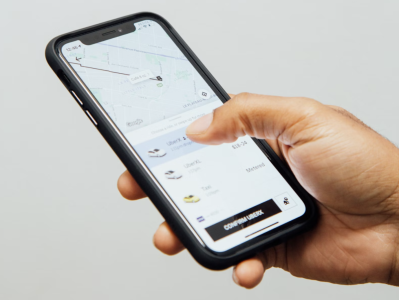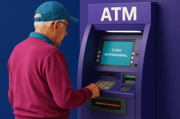Half-price Uber rides? New proposal could deliver major savings for Aussies
- Replies 0
For many Australians, especially those living with disabilities or mobility challenges, getting from A to B isn’t just about convenience—it’s about independence, dignity, and staying connected to the community.
But what if the very systems designed to help are actually making things harder?
For thousands of Australians like Bruce Maguire, who is blind and partially deaf, accessible transport is essential to living independently and with confidence.
But for Bruce, who lives in Sydney, taking a taxi often triggers stress. In 2020, New South Wales replaced paper taxi vouchers with a smart card system under the Taxi Transport Subsidy Scheme (TTSS), aimed at helping residents with mobility or vision impairments. However, Bruce said the system has only become more frustrating over time.
‘The basic problem is that since the introduction of the so-called smart card, the operation of the scheme has become much more problematic,’ Bruce told Yahoo News. ‘When we were using paper vouchers, every taxi driver in NSW could accept them, and there was never any doubt about that.
‘The vouchers didn’t expire, so you didn’t have to worry about whether or not you could use them. But since the card was introduced in 2020, to use it, the taxi has to have a Cabcharge terminal. Not all taxis have them, and as a blind person, when I get in, I don’t know what terminal it’s got.’

‘Vouchers give you a 50 per cent discount up to a maximum of $120 trips, so essentially half fare on many taxi trips,’ he explained. ‘But if the taxi driver says to me, “I can’t process the card because I don’t have the right terminal,” I don’t know whether he’s telling the truth or not. And if he doesn’t have the card reader he’s supposed to have, you have to carry paper vouchers in case the card can’t be processed.
‘What’s the point of the card in the first place if you still have to have paper?
‘The other issue is that the card expires in three years, and you have to have it renewed. If you don’t get the notification that it’s expired or you don’t get around to renewing it in time, you can’t use it. That was never an issue with paper vouchers.’
In earlier news: Secret video exposes $59 taxi scam, warning for Aussie passengers
Bruce, who works as a policy advisor at Vision Australia, said the new system has fallen short. ‘The smart card hasn’t been all that smart.’
Survey data gathered by the organisation showed many users are dissatisfied, with 53 per cent of NSW respondents saying they’d be more likely to use the TTSS if it included rideshare services like Uber.
‘I get into an Uber, I know exactly how far away the driver is — the app tells me 800 metres away, 200 metres away, 20 metres away — and then there it is. I get in, we arrive at the destination, I get out. It’s all done. I don’t have to worry about it,’ Bruce said.
‘The rest of the community has had a choice for 12 years as to whether they use taxis or rideshare, and there are advantages for people who are blind in using rideshare — just as there can be advantages in using taxis — but we don’t have the choice because the TTSS only applies to taxis.
‘I got a taxi recently ... and the app said it was on its way, but I had no idea what that meant. Ten minutes away? Thirty minutes away?’
Since 2021, Victoria’s Multi-Purpose Taxi Program has included subsidised Uber rides, a change that’s been widely embraced. Survey results show 97 per cent of Victorian users either increased or maintained their use of the scheme after rideshare was added.
While acknowledging that challenges remain—such as ongoing instances of dog guide refusals—Bruce and Vision Australia argue that people with disabilities should have the same transport choices as everyone else.
‘We’re not criticising the majority of taxi drivers, but it’s the infrastructure and technology that taxis are using that just doesn’t work as well,’ Bruce said.
‘But I have just given up using the TTSS. I just paid the full fare. I just can't be bothered with the hassle of figuring out what the meter says and what it doesn’t say — and then arguing about what the amount of subsidy should be. If I forget to tell the driver at the start of the trip that I want to use the TTSS, and he doesn’t turn the meter on, then there’s no way you can use it.
‘It’s about choice. The rest of the community has the choice — we think people who are blind should have the same choice the rest of the community has.’
Bruce added that if Victoria can implement the change, there’s no reason NSW and other states can’t follow.
‘Part of this commitment includes the recent announcement to deliver an emergency funding package of $15 million over one year to address a critical shortage of wheelchair accessible taxis,’ the spokesperson told Yahoo.
They added that development is underway for longer-term support measures, including a review of the TTSS to ‘improve access to accessible service providers across the industry’. That includes exploring options to expand the subsidy to other authorised providers, such as rideshare services.
‘Options are also being explored for long-term funding to support reforms which deliver sustainable, accessible point-to-point transport,’ the spokesperson said.
They confirmed that Transport for NSW is aware of the access challenges many users face—including with TTSS—and will continue working with the disability community as part of ongoing reforms.
Read next: Community transport companies refuse new clients as demand surges

We want to hear from you, members! Have you or someone you know struggled with the current taxi subsidy system? Would you use Uber or another rideshare service if you could get a 50% discount? Do you think all states should follow Victoria’s lead? Share your thoughts and experiences in the comments below!
But what if the very systems designed to help are actually making things harder?
For thousands of Australians like Bruce Maguire, who is blind and partially deaf, accessible transport is essential to living independently and with confidence.
But for Bruce, who lives in Sydney, taking a taxi often triggers stress. In 2020, New South Wales replaced paper taxi vouchers with a smart card system under the Taxi Transport Subsidy Scheme (TTSS), aimed at helping residents with mobility or vision impairments. However, Bruce said the system has only become more frustrating over time.
‘The basic problem is that since the introduction of the so-called smart card, the operation of the scheme has become much more problematic,’ Bruce told Yahoo News. ‘When we were using paper vouchers, every taxi driver in NSW could accept them, and there was never any doubt about that.
‘The vouchers didn’t expire, so you didn’t have to worry about whether or not you could use them. But since the card was introduced in 2020, to use it, the taxi has to have a Cabcharge terminal. Not all taxis have them, and as a blind person, when I get in, I don’t know what terminal it’s got.’

Many Australians with disabilities face ongoing challenges with NSW's Taxi Transport Subsidy Scheme (TTSS) due to the mandatory use of a 'smart card', which is not universally supported by all taxis and can expire, creating confusion and inconvenience. Image source: charlesdeluvio / Unsplash.
TTSS smart card system creating confusion
Bruce said many eligible passengers across the state are now being left to pay full fares because the discount often can’t be processed.‘Vouchers give you a 50 per cent discount up to a maximum of $120 trips, so essentially half fare on many taxi trips,’ he explained. ‘But if the taxi driver says to me, “I can’t process the card because I don’t have the right terminal,” I don’t know whether he’s telling the truth or not. And if he doesn’t have the card reader he’s supposed to have, you have to carry paper vouchers in case the card can’t be processed.
‘What’s the point of the card in the first place if you still have to have paper?
‘The other issue is that the card expires in three years, and you have to have it renewed. If you don’t get the notification that it’s expired or you don’t get around to renewing it in time, you can’t use it. That was never an issue with paper vouchers.’
In earlier news: Secret video exposes $59 taxi scam, warning for Aussie passengers
Bruce, who works as a policy advisor at Vision Australia, said the new system has fallen short. ‘The smart card hasn’t been all that smart.’
Survey data gathered by the organisation showed many users are dissatisfied, with 53 per cent of NSW respondents saying they’d be more likely to use the TTSS if it included rideshare services like Uber.
‘I get into an Uber, I know exactly how far away the driver is — the app tells me 800 metres away, 200 metres away, 20 metres away — and then there it is. I get in, we arrive at the destination, I get out. It’s all done. I don’t have to worry about it,’ Bruce said.
‘The rest of the community has had a choice for 12 years as to whether they use taxis or rideshare, and there are advantages for people who are blind in using rideshare — just as there can be advantages in using taxis — but we don’t have the choice because the TTSS only applies to taxis.
‘I got a taxi recently ... and the app said it was on its way, but I had no idea what that meant. Ten minutes away? Thirty minutes away?’
Advocates urge NSW to follow Victoria’s lead on rideshare subsidies
Bruce and Vision Australia are now calling on the NSW Government — and other states — to expand their subsidy programs to include rideshare providers, as Victoria has already done.Since 2021, Victoria’s Multi-Purpose Taxi Program has included subsidised Uber rides, a change that’s been widely embraced. Survey results show 97 per cent of Victorian users either increased or maintained their use of the scheme after rideshare was added.
While acknowledging that challenges remain—such as ongoing instances of dog guide refusals—Bruce and Vision Australia argue that people with disabilities should have the same transport choices as everyone else.
‘We’re not criticising the majority of taxi drivers, but it’s the infrastructure and technology that taxis are using that just doesn’t work as well,’ Bruce said.
‘But I have just given up using the TTSS. I just paid the full fare. I just can't be bothered with the hassle of figuring out what the meter says and what it doesn’t say — and then arguing about what the amount of subsidy should be. If I forget to tell the driver at the start of the trip that I want to use the TTSS, and he doesn’t turn the meter on, then there’s no way you can use it.
‘It’s about choice. The rest of the community has the choice — we think people who are blind should have the same choice the rest of the community has.’
Bruce added that if Victoria can implement the change, there’s no reason NSW and other states can’t follow.
Government response
In response, a Transport for NSW spokesperson said the agency is ‘committed to ensuring that everyone in NSW, particularly people with disability,’ has access to point-to-point transport, including both taxis and rideshare.‘Part of this commitment includes the recent announcement to deliver an emergency funding package of $15 million over one year to address a critical shortage of wheelchair accessible taxis,’ the spokesperson told Yahoo.
They added that development is underway for longer-term support measures, including a review of the TTSS to ‘improve access to accessible service providers across the industry’. That includes exploring options to expand the subsidy to other authorised providers, such as rideshare services.
‘Options are also being explored for long-term funding to support reforms which deliver sustainable, accessible point-to-point transport,’ the spokesperson said.
They confirmed that Transport for NSW is aware of the access challenges many users face—including with TTSS—and will continue working with the disability community as part of ongoing reforms.
Read next: Community transport companies refuse new clients as demand surges
Key Takeaways
- Many Australians with disabilities face ongoing challenges with NSW's Taxi Transport Subsidy Scheme (TTSS) due to the mandatory use of a 'smart card', which is not universally supported by all taxis and can expire, creating confusion and inconvenience.
- There are increasing calls, led by Vision Australia, to expand the TTSS to include rideshare providers like Uber, as Victoria has already done successfully, giving people with disabilities more choice and flexibility.
- Survey data shows that over half of NSW participants would be more likely to use the subsidy scheme if rideshare options were available, with the majority of Victorian users reporting improved or stable uptake since Uber was added.
- Transport for NSW has announced emergency funding and is reviewing the TTSS, with plans to improve accessibility and potentially extend transport subsidies to rideshare providers in the future.
We want to hear from you, members! Have you or someone you know struggled with the current taxi subsidy system? Would you use Uber or another rideshare service if you could get a 50% discount? Do you think all states should follow Victoria’s lead? Share your thoughts and experiences in the comments below!







